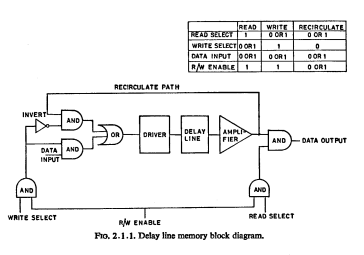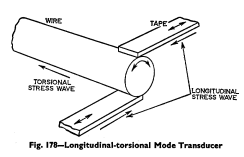Delay line stores
In an acoustic delay line store ("memory"), bits are inserted sequentially into one end of a long metal wire as acoustic pulses, by means of a transducer (see below). These pulses propagate along the wire at the speed of sound, until they arrive at the other end where they are translated back into electrical pulses by another transducer. By making an electrical connection between both transducers, the loop is closed and a pattern of pulses, representing the information to be stored, circulates indefinitely (that is, as long as the power supply remains uninterrupted!).Using an arrangement of logic gates, bits can be extracted from or added to the system. A clock pulse generator is used for defining the time slots during which read/write transfers can take place; a counter keeps track of the location of the bit patterns.

Translating electric pulses into acoustic pulses is accomplished using the effect of magnetostriction: applying a magnetic field to a magnetostrictive material (such as nickel) causes a mechanical strain. The delay line material is itself not magnetostrictive. Torsional impulses are induced in it by means of a pair of nickel ribbons attached to the end of the wire (see the figure). The ribbons pass through a pair of coils which generate magnetic pulses in opposite directions for each incoming (electric) bit pulse. At the other end of the line, a similar arrangement is used to translate the arriving acoustic pulses back into electric pulses. On both ends, the delay line is terminated with neoprene damping pads in order to prevent pulses from being reflected back into the line.

References:
- Haley and Scott (eds): Analogue and Digital Computers. Newness 1960
- Middelhoek, George and Dekker: Physics of Computer Memory Devices. Academic Press 1976
